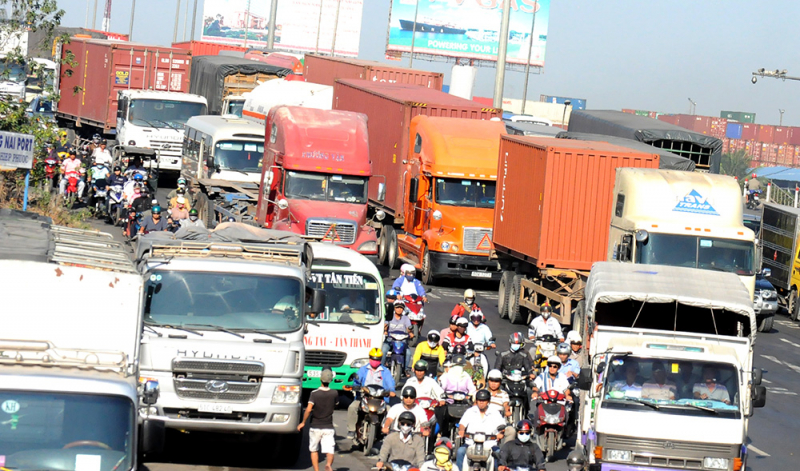To reduce traffic congestion on National Highway 1, on August 28, Mr. Bui Xuan Cuong, Vice Chairman of Ho Chi Minh City People's Committee, issued a decision approving the architectural plan for Kinh Duong Vuong overpass, Binh Dien bridge and Binh Thuan intersection construction items. These are works under Component Project 3 - Upgrading and expanding National Highway 1 and will be invested in the form of public-private partnership, BOT contract.
The goal is to build a 4-lane overpass at the Kinh Duong Vuong intersection on National Highway 1 across Kinh Duong Vuong and Tran Dai Nghia streets. Binh Dien Bridge on National Highway 1 across Cho Dem River will be built into 2 bridges in 2 phases. Binh Thuan intersection on National Highway 1 intersecting with Nguyen Van Linh Street will have 2 overpasses built to further expand National Highway 1, 2 underpasses with 4 lanes connecting Nguyen Van Linh Street with Ho Chi Minh City - Trung Luong Expressway and 1 pedestrian bridge. The time for design consulting companies, organizations or consortia to participate in the architectural design competition for the above overpasses lasted more than 2 months.

The owner of a business specializing in traffic construction in this area said that not only the intersections with Highway 1, but also the section of Highway 1 running through the old Binh Tan and Binh Chanh areas is often congested. Therefore, the city needs to consider this an urgent project to apply a special mechanism for the project. At the same time, the authorities need to install cameras to monitor traffic flow from all directions, during daily time frames, before coming up with a plan when designing and building suitable overpasses and underpasses.
Most provinces and cities have already built a National Highway 1 bypass through large urban areas with high population density, but on the contrary, a large city like Ho Chi Minh City has not yet built a National Highway 1 bypass. In addition to the travel needs of the city's residents, National Highway 1 also ensures the entire volume of cars traveling from the Southeast region to the Mekong Delta as well as the volume of cars traveling in the North - South direction and vice versa. Therefore, although most of the length of National Highway 1 through Ho Chi Minh City has been installed with a hard median to separate lanes for cars and motorbikes, with only 2 car lanes, the road surface is still often congested. At intersections with National Highway 1, long traffic jams often occur.
To reduce the load on National Highway 1, more than 10 years ago, Ho Chi Minh City planned the Ring Road 2. The essence of this project is just to build connecting sections to close Nguyen Van Linh Street with National Highway 1 to create a route around the inner city. But up to now, Ho Chi Minh City's Ring Road 2 with a total length of 64km, with a scale of 6-10 lanes, has not been completed despite the existence of the two existing routes. Specifically, in addition to the connecting section from Pham Van Dong Street to National Highway 1 which is under construction and waiting for obstacles to be resolved, there are also sections from Phu Huu Bridge to Vo Nguyen Giap Street; the section from Vo Nguyen Giap Street to Pham Van Dong Street and the section connecting from National Highway 1 to Nguyen Van Linh Street. The Ring Road 2 project had to be divided into many sections with many component projects, but up to now, the 14km of Ring Road 2 connecting the two routes above has not been completed.
Mr. Tran Thanh Loc, Deputy Head of the PPP Project Management Board - City Traffic Construction Investment Project Management Board (Traffic Board) said that in September 2023, the City People's Council issued a Resolution approving the investment policy for the section from Phu Huu Bridge to Vo Nguyen Giap Street. The total investment from the budget for the construction part is 2,653 billion VND, but the amount to be spent on compensation and clearance has reached 6,675 billion VND. The investment rate for 3.5km of Ring Road 2 of the above section is at 2,800 billion VND/km.
Regarding the section of Ring Road 2 connecting Vo Nguyen Giap to Pham Van Dong Street, Mr. Hoang Huu Hung, Deputy Head of the PPP Project Management Board - Traffic Department, informed that the total budget investment for this 2.8km section has been estimated at VND4,543 billion. Of which, the amount for compensation and site clearance is VND1,956 billion; the construction cost is VND2,587 billion, equivalent to an investment rate of more than VND1,500 billion per km. Particularly for the section connecting National Highway 1 to Nguyen Van Linh Street with a length of 5.3km, the total investment is expected to be up to VND16,417 billion. Of which, the compensation and site clearance alone is about VND13,190 billion. With the above total investment, the investment rate of Ring Road 2 for this section is at VND3,000 billion/km.
Thus, if public investment is used, the budget will have to bear the "huge" investment cost of the Ring Road 2 Project; and if BOT investment is used, people will certainly have to pay higher fees or pay fees for a longer period of time. But even though it is late, Ho Chi Minh City needs to "correct mistakes", invest synchronously in the Ring Road 2 Project along with the implementation of the National Highway 1 expansion component project to create more traffic directions for vehicles in the area surrounding the inner city, reducing the current overload of vehicles on National Highway 1.
Source: https://cand.com.vn/Giao-thong/mo-rong-ql-1-doan-qua-tp-ho-chi-minh-phai-gan-voi-dau-tu-khep-kin-duong-vanh-dai-2-i780846/






![[Photo] President Luong Cuong hosts state reception for Governor-General of Australia](https://vphoto.vietnam.vn/thumb/1200x675/vietnam/resource/IMAGE/2025/9/10/a00546a3d7364bbc81ee51aae9ef8383)
![[Photo] Prime Minister Pham Minh Chinh chairs the 20th meeting of the Steering Committee for important national projects and works](https://vphoto.vietnam.vn/thumb/1200x675/vietnam/resource/IMAGE/2025/9/10/e82d71fd36eb4bcd8529c8828d64f17c)
![[Photo] Giant pipeline leading water to West Lake, contributing to reviving To Lich River](https://vphoto.vietnam.vn/thumb/1200x675/vietnam/resource/IMAGE/2025/9/10/887e1aab2cc643a0b2ef2ffac7cb00b4)




















































































Comment (0)